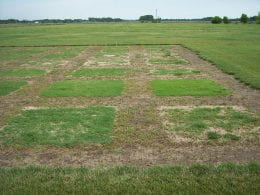
There are various ways to keep crowns covered, some are more practical than others. One excellent cover is snow. In 2021, air temperatures in Kansas reached -18 F in the eastern part of the state and low temperature extremes occurred in southern states too. For example, parts of southern Texas reached temperatures as low as 5 F in mid-February. A municipal park manager in southern Kansas had sodded Latitude 36 bermudagrass, a cultivar with good cold hardiness, on baseball fields and dog parks in late summer 2020 and was quite concerned about its survival following the February temperature plunge. When April arrived in our state, I visited the location to investigate the extent of winterkill, but it was minimal. About 4 inches of snow helped insulate the crowns. In other areas of the transition zone and upper South that had no snow cover, some extensive winterkill of bermudagrass and other warm-season grasses occurred.
There are other, more reliable ways to protect the crowns of warm-season grasses, as snow may not always be present when temperatures like this happen. Soil provides a warm blanket for crowns. When air temperatures drop below 0 F, it is common for temperatures just below the soil surface to be significantly higher. In Kansas in Februrary, 2021, lowest soil temperatures at a 2 inch depth were generally at least 40 F warmer than the lowest air temperature that occurred (e.g. air at -18F, soil at about 25 F). Soil provides a very nice blanket for crowns. It confirms that keeping crowns from rising above the soil by minimizing thatch accumulation is important, and removing thatch may be needed if it becomes excessive. For crowns that are above the surface, topdressing will help create a warmer environment during winter.
Keep ’em covered!
